Dissertation: Health and Safety in Oil and Gas Transportation, Nigeria
VerifiedAdded on 2023/06/03
|44
|11645
|263
Thesis and Dissertation
AI Summary
This dissertation presents a comprehensive evaluation of health and safety management practices within the transportation of oil and gas products in Nigeria. The study investigates the increasing number of accidents in the sector and their impact on stakeholders. It examines existing health and safety management practices, analyzes the regulatory frameworks, and explores accident causation using the Swiss Cheese model. The research utilizes a qualitative methodology, analyzing secondary data from journals, articles, and newspapers. The findings highlight the rise in accidents across different transportation modes (pipeline, rail, and tankers), emphasizing the need for robust safety measures and regulatory compliance. The dissertation also addresses the role of the Federal Road Safety Corps (FRSC) in enforcing safety regulations. This research paper aims to serve as a basis for discussion of transportation of oil and gas products in Nigeria in meeting health and safety frameworks. This study helps to identify how and what health and safety framework is applied to mitigate the risks and harm caused by accidents.
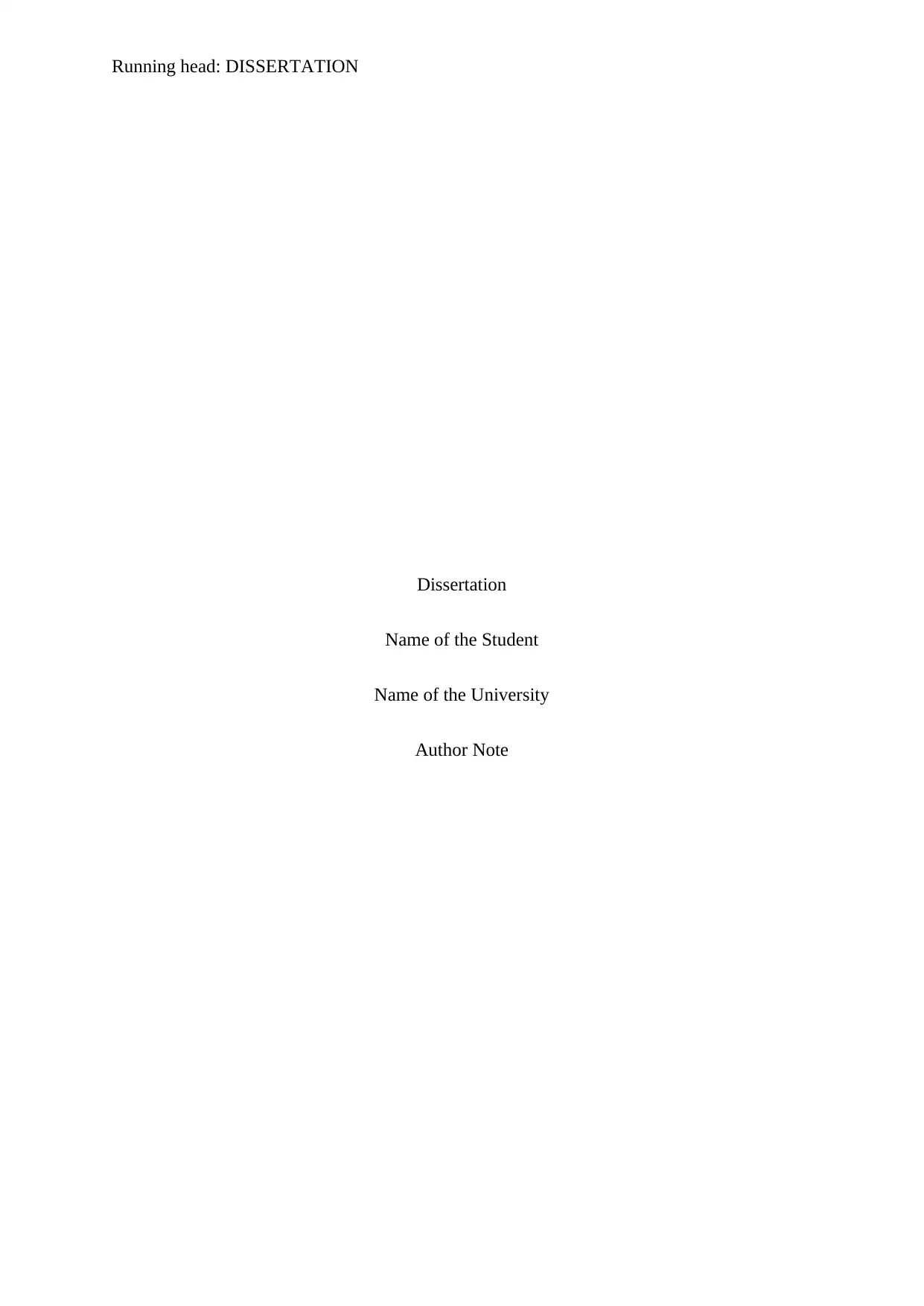
Running head: DISSERTATION
Dissertation
Name of the Student
Name of the University
Author Note
Dissertation
Name of the Student
Name of the University
Author Note
Paraphrase This Document
Need a fresh take? Get an instant paraphrase of this document with our AI Paraphraser

1DISSERTATION
Abstract
This research project is a detailed evaluation of health and safety management practices in
transportation of oil and gas products. The major purpose of the project is to evaluate health
and management practices followed and implemented by oil and gas organizations when
transporting the petroleum products. The introductory chapter of the dissertation presents a
detail background to the significance of health and safety requirements in transporting oil and
gas products in Nigeria. From the background of the study has been found that health and
safety has become a mandatory requirements in the sector as there is a rapid increase in
number of accidents when transporting the products. The major objective of the study is to
investigate the accidents occur during the transportation of petroleum products and its impact
on stakeholders involved. Likewise, two other significant objectives have been formed. The
study uses a qualitative method in which qualitative data has been analysed. For qualitative
data analysis, secondary data has been collected from books, journal articles and newspaper
articles. The study uses a non-probability sampling method to select the journal articles for
the data analysis. The findings of the study indicates that during the period 2004 to 2014, the
number of accidents in all modes of transportation such as by rail, by pipeline and tankers has
increased by a great number. On the basis of different modes of transportation, it is found that
transportation through pipeline is more convenient than other mode of transportation. Major
responsbility of FRSC should include monitoring, certifying as well as enforicng compliance
regulations governing safety oeprations of articulated vehicles in the nation. Similarly, there
are several safety measures imposed by Nigeria government have been found and they are
presented in the findings.
Abstract
This research project is a detailed evaluation of health and safety management practices in
transportation of oil and gas products. The major purpose of the project is to evaluate health
and management practices followed and implemented by oil and gas organizations when
transporting the petroleum products. The introductory chapter of the dissertation presents a
detail background to the significance of health and safety requirements in transporting oil and
gas products in Nigeria. From the background of the study has been found that health and
safety has become a mandatory requirements in the sector as there is a rapid increase in
number of accidents when transporting the products. The major objective of the study is to
investigate the accidents occur during the transportation of petroleum products and its impact
on stakeholders involved. Likewise, two other significant objectives have been formed. The
study uses a qualitative method in which qualitative data has been analysed. For qualitative
data analysis, secondary data has been collected from books, journal articles and newspaper
articles. The study uses a non-probability sampling method to select the journal articles for
the data analysis. The findings of the study indicates that during the period 2004 to 2014, the
number of accidents in all modes of transportation such as by rail, by pipeline and tankers has
increased by a great number. On the basis of different modes of transportation, it is found that
transportation through pipeline is more convenient than other mode of transportation. Major
responsbility of FRSC should include monitoring, certifying as well as enforicng compliance
regulations governing safety oeprations of articulated vehicles in the nation. Similarly, there
are several safety measures imposed by Nigeria government have been found and they are
presented in the findings.
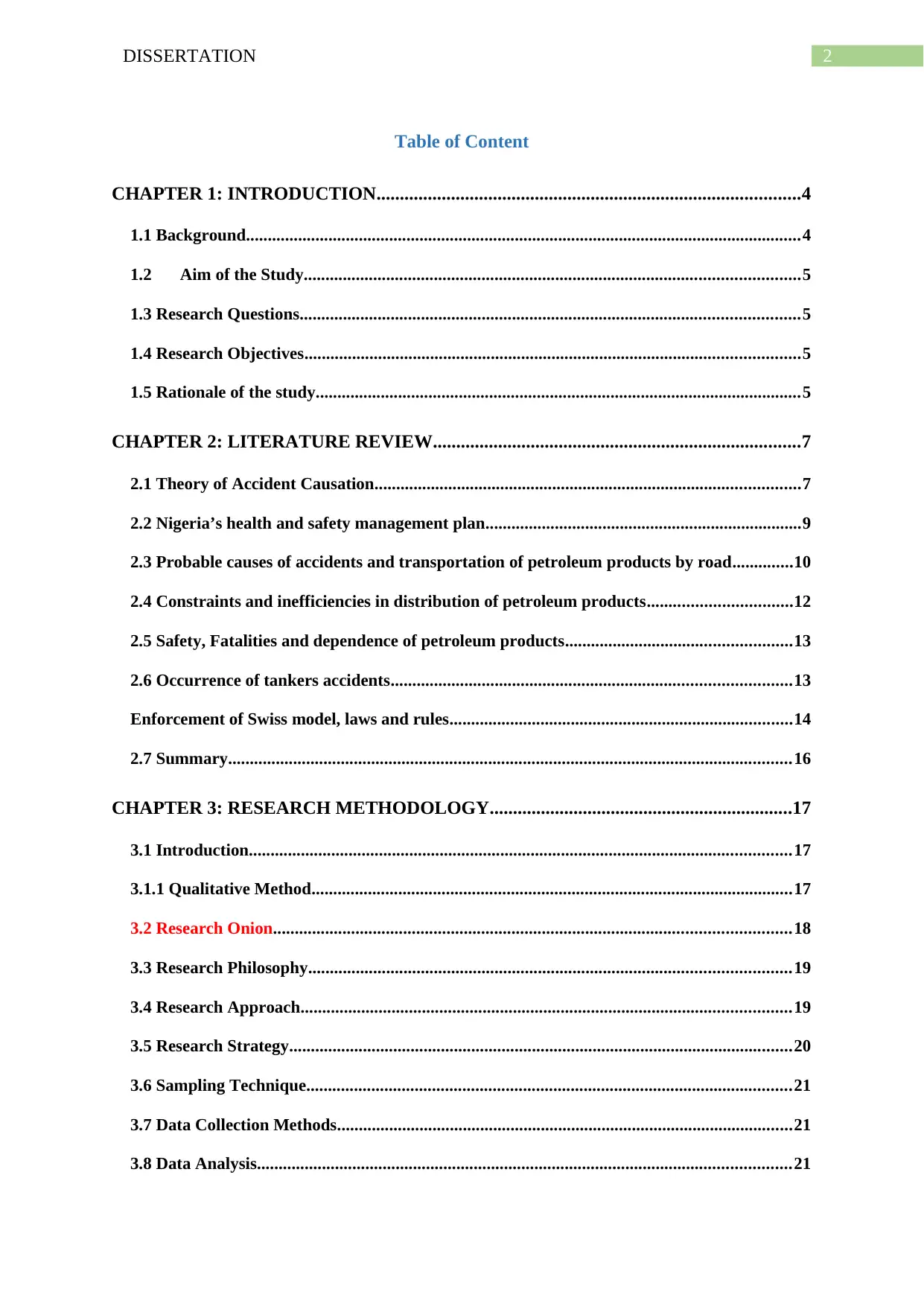
2DISSERTATION
Table of Content
CHAPTER 1: INTRODUCTION...........................................................................................4
1.1 Background................................................................................................................................4
1.2 Aim of the Study..................................................................................................................5
1.3 Research Questions...................................................................................................................5
1.4 Research Objectives..................................................................................................................5
1.5 Rationale of the study................................................................................................................5
CHAPTER 2: LITERATURE REVIEW...............................................................................7
2.1 Theory of Accident Causation..................................................................................................7
2.2 Nigeria’s health and safety management plan.........................................................................9
2.3 Probable causes of accidents and transportation of petroleum products by road..............10
2.4 Constraints and inefficiencies in distribution of petroleum products.................................12
2.5 Safety, Fatalities and dependence of petroleum products....................................................13
2.6 Occurrence of tankers accidents............................................................................................13
Enforcement of Swiss model, laws and rules...............................................................................14
2.7 Summary..................................................................................................................................16
CHAPTER 3: RESEARCH METHODOLOGY.................................................................17
3.1 Introduction.............................................................................................................................17
3.1.1 Qualitative Method...............................................................................................................17
3.2 Research Onion.......................................................................................................................18
3.3 Research Philosophy...............................................................................................................19
3.4 Research Approach.................................................................................................................19
3.5 Research Strategy....................................................................................................................20
3.6 Sampling Technique................................................................................................................21
3.7 Data Collection Methods.........................................................................................................21
3.8 Data Analysis...........................................................................................................................21
Table of Content
CHAPTER 1: INTRODUCTION...........................................................................................4
1.1 Background................................................................................................................................4
1.2 Aim of the Study..................................................................................................................5
1.3 Research Questions...................................................................................................................5
1.4 Research Objectives..................................................................................................................5
1.5 Rationale of the study................................................................................................................5
CHAPTER 2: LITERATURE REVIEW...............................................................................7
2.1 Theory of Accident Causation..................................................................................................7
2.2 Nigeria’s health and safety management plan.........................................................................9
2.3 Probable causes of accidents and transportation of petroleum products by road..............10
2.4 Constraints and inefficiencies in distribution of petroleum products.................................12
2.5 Safety, Fatalities and dependence of petroleum products....................................................13
2.6 Occurrence of tankers accidents............................................................................................13
Enforcement of Swiss model, laws and rules...............................................................................14
2.7 Summary..................................................................................................................................16
CHAPTER 3: RESEARCH METHODOLOGY.................................................................17
3.1 Introduction.............................................................................................................................17
3.1.1 Qualitative Method...............................................................................................................17
3.2 Research Onion.......................................................................................................................18
3.3 Research Philosophy...............................................................................................................19
3.4 Research Approach.................................................................................................................19
3.5 Research Strategy....................................................................................................................20
3.6 Sampling Technique................................................................................................................21
3.7 Data Collection Methods.........................................................................................................21
3.8 Data Analysis...........................................................................................................................21
⊘ This is a preview!⊘
Do you want full access?
Subscribe today to unlock all pages.

Trusted by 1+ million students worldwide
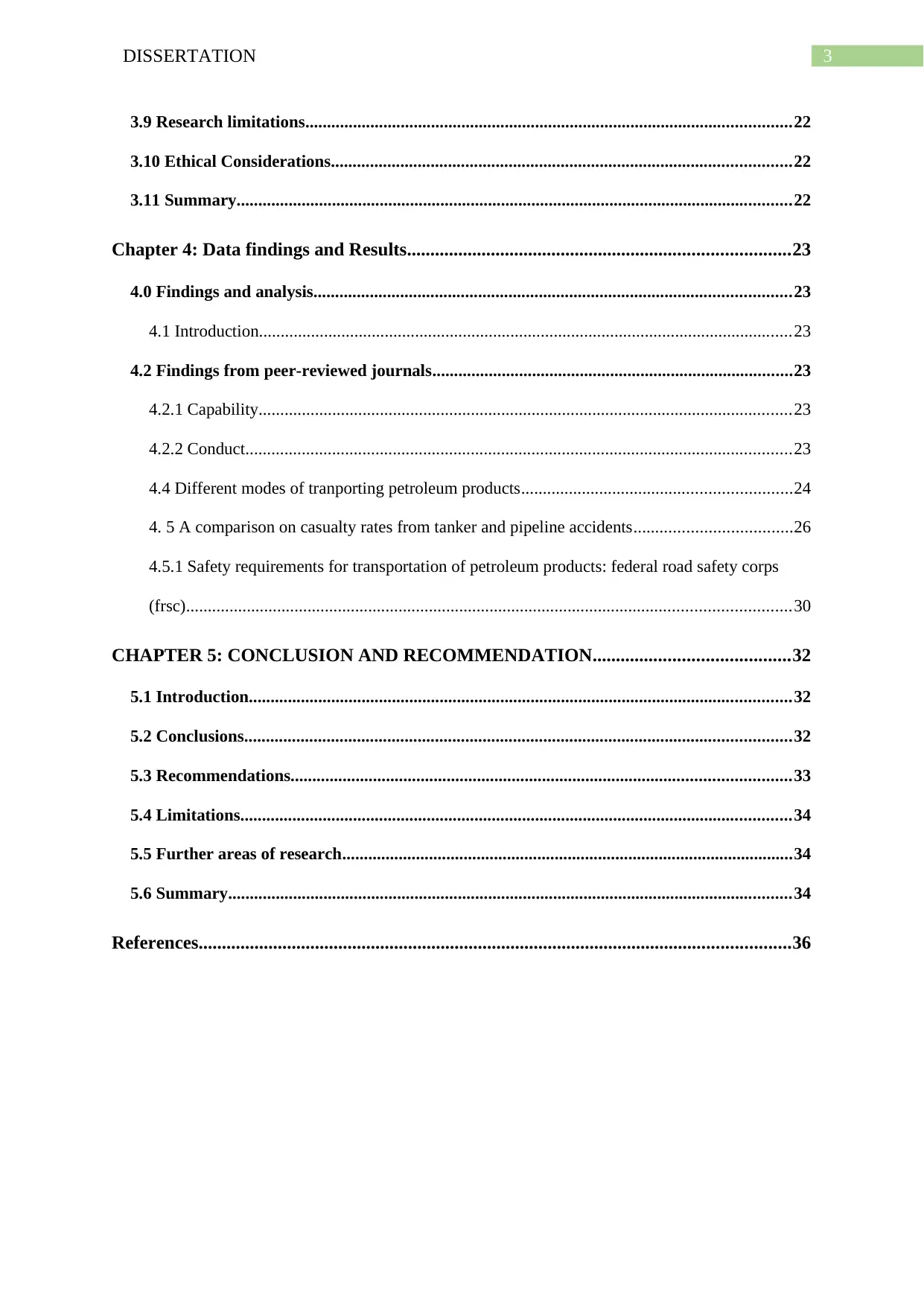
3DISSERTATION
3.9 Research limitations................................................................................................................22
3.10 Ethical Considerations..........................................................................................................22
3.11 Summary................................................................................................................................22
Chapter 4: Data findings and Results..................................................................................23
4.0 Findings and analysis..............................................................................................................23
4.1 Introduction...........................................................................................................................23
4.2 Findings from peer-reviewed journals...................................................................................23
4.2.1 Capability...........................................................................................................................23
4.2.2 Conduct..............................................................................................................................23
4.4 Different modes of tranporting petroleum products..............................................................24
4. 5 A comparison on casualty rates from tanker and pipeline accidents....................................26
4.5.1 Safety requirements for transportation of petroleum products: federal road safety corps
(frsc)...........................................................................................................................................30
CHAPTER 5: CONCLUSION AND RECOMMENDATION..........................................32
5.1 Introduction.............................................................................................................................32
5.2 Conclusions..............................................................................................................................32
5.3 Recommendations...................................................................................................................33
5.4 Limitations...............................................................................................................................34
5.5 Further areas of research........................................................................................................34
5.6 Summary..................................................................................................................................34
References...............................................................................................................................36
3.9 Research limitations................................................................................................................22
3.10 Ethical Considerations..........................................................................................................22
3.11 Summary................................................................................................................................22
Chapter 4: Data findings and Results..................................................................................23
4.0 Findings and analysis..............................................................................................................23
4.1 Introduction...........................................................................................................................23
4.2 Findings from peer-reviewed journals...................................................................................23
4.2.1 Capability...........................................................................................................................23
4.2.2 Conduct..............................................................................................................................23
4.4 Different modes of tranporting petroleum products..............................................................24
4. 5 A comparison on casualty rates from tanker and pipeline accidents....................................26
4.5.1 Safety requirements for transportation of petroleum products: federal road safety corps
(frsc)...........................................................................................................................................30
CHAPTER 5: CONCLUSION AND RECOMMENDATION..........................................32
5.1 Introduction.............................................................................................................................32
5.2 Conclusions..............................................................................................................................32
5.3 Recommendations...................................................................................................................33
5.4 Limitations...............................................................................................................................34
5.5 Further areas of research........................................................................................................34
5.6 Summary..................................................................................................................................34
References...............................................................................................................................36
Paraphrase This Document
Need a fresh take? Get an instant paraphrase of this document with our AI Paraphraser
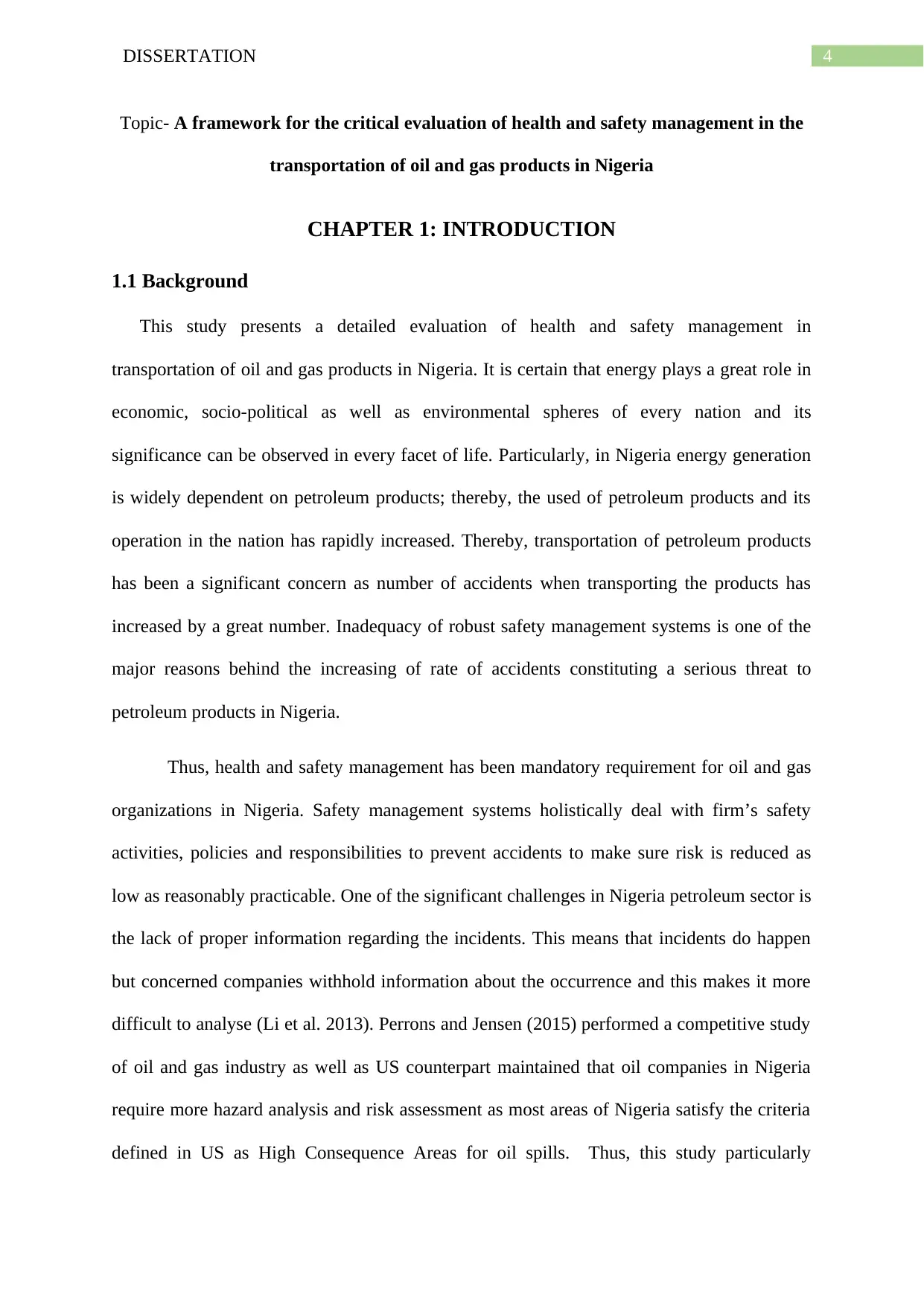
4DISSERTATION
Topic- A framework for the critical evaluation of health and safety management in the
transportation of oil and gas products in Nigeria
CHAPTER 1: INTRODUCTION
1.1 Background
This study presents a detailed evaluation of health and safety management in
transportation of oil and gas products in Nigeria. It is certain that energy plays a great role in
economic, socio-political as well as environmental spheres of every nation and its
significance can be observed in every facet of life. Particularly, in Nigeria energy generation
is widely dependent on petroleum products; thereby, the used of petroleum products and its
operation in the nation has rapidly increased. Thereby, transportation of petroleum products
has been a significant concern as number of accidents when transporting the products has
increased by a great number. Inadequacy of robust safety management systems is one of the
major reasons behind the increasing of rate of accidents constituting a serious threat to
petroleum products in Nigeria.
Thus, health and safety management has been mandatory requirement for oil and gas
organizations in Nigeria. Safety management systems holistically deal with firm’s safety
activities, policies and responsibilities to prevent accidents to make sure risk is reduced as
low as reasonably practicable. One of the significant challenges in Nigeria petroleum sector is
the lack of proper information regarding the incidents. This means that incidents do happen
but concerned companies withhold information about the occurrence and this makes it more
difficult to analyse (Li et al. 2013). Perrons and Jensen (2015) performed a competitive study
of oil and gas industry as well as US counterpart maintained that oil companies in Nigeria
require more hazard analysis and risk assessment as most areas of Nigeria satisfy the criteria
defined in US as High Consequence Areas for oil spills. Thus, this study particularly
Topic- A framework for the critical evaluation of health and safety management in the
transportation of oil and gas products in Nigeria
CHAPTER 1: INTRODUCTION
1.1 Background
This study presents a detailed evaluation of health and safety management in
transportation of oil and gas products in Nigeria. It is certain that energy plays a great role in
economic, socio-political as well as environmental spheres of every nation and its
significance can be observed in every facet of life. Particularly, in Nigeria energy generation
is widely dependent on petroleum products; thereby, the used of petroleum products and its
operation in the nation has rapidly increased. Thereby, transportation of petroleum products
has been a significant concern as number of accidents when transporting the products has
increased by a great number. Inadequacy of robust safety management systems is one of the
major reasons behind the increasing of rate of accidents constituting a serious threat to
petroleum products in Nigeria.
Thus, health and safety management has been mandatory requirement for oil and gas
organizations in Nigeria. Safety management systems holistically deal with firm’s safety
activities, policies and responsibilities to prevent accidents to make sure risk is reduced as
low as reasonably practicable. One of the significant challenges in Nigeria petroleum sector is
the lack of proper information regarding the incidents. This means that incidents do happen
but concerned companies withhold information about the occurrence and this makes it more
difficult to analyse (Li et al. 2013). Perrons and Jensen (2015) performed a competitive study
of oil and gas industry as well as US counterpart maintained that oil companies in Nigeria
require more hazard analysis and risk assessment as most areas of Nigeria satisfy the criteria
defined in US as High Consequence Areas for oil spills. Thus, this study particularly
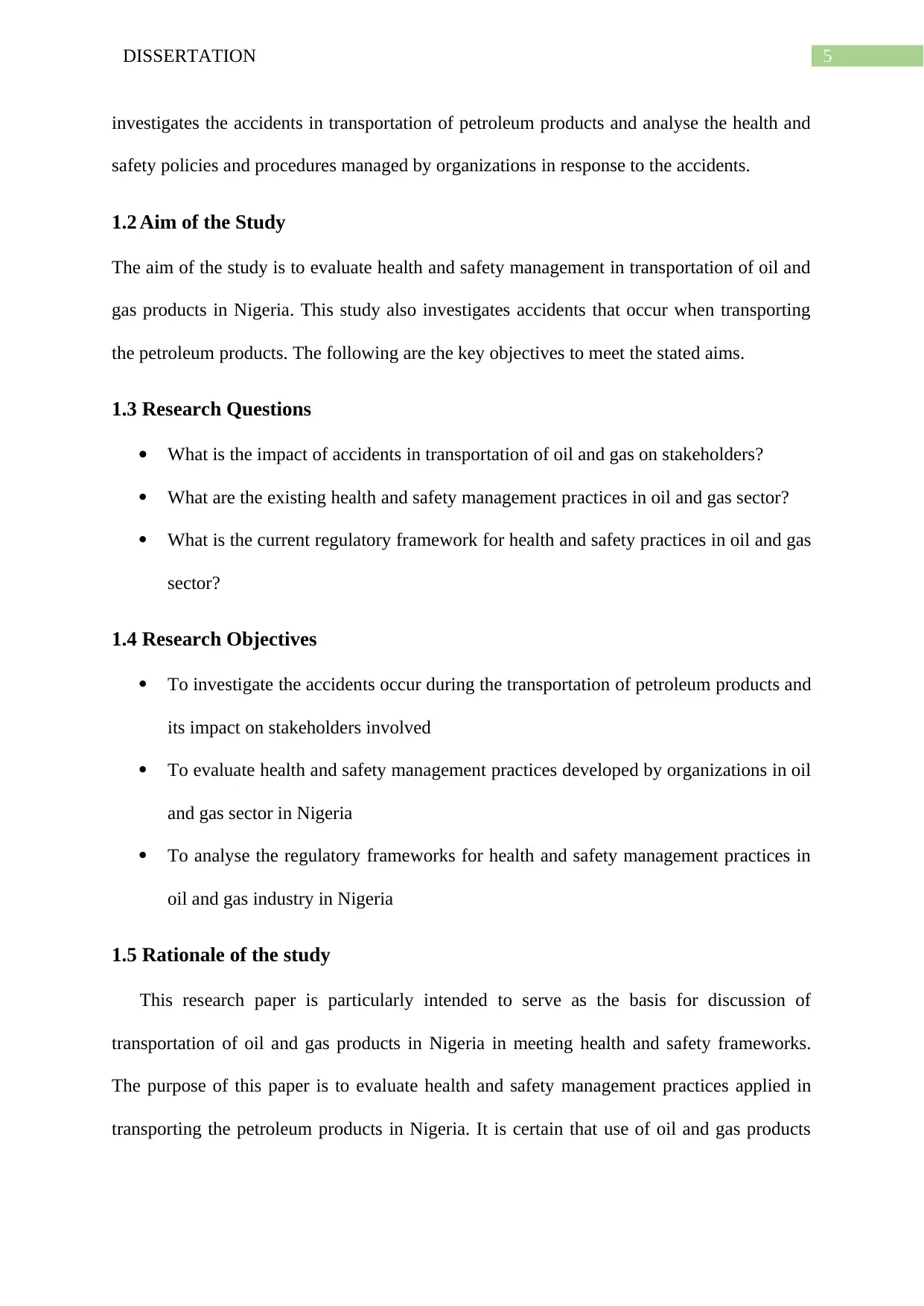
5DISSERTATION
investigates the accidents in transportation of petroleum products and analyse the health and
safety policies and procedures managed by organizations in response to the accidents.
1.2 Aim of the Study
The aim of the study is to evaluate health and safety management in transportation of oil and
gas products in Nigeria. This study also investigates accidents that occur when transporting
the petroleum products. The following are the key objectives to meet the stated aims.
1.3 Research Questions
What is the impact of accidents in transportation of oil and gas on stakeholders?
What are the existing health and safety management practices in oil and gas sector?
What is the current regulatory framework for health and safety practices in oil and gas
sector?
1.4 Research Objectives
To investigate the accidents occur during the transportation of petroleum products and
its impact on stakeholders involved
To evaluate health and safety management practices developed by organizations in oil
and gas sector in Nigeria
To analyse the regulatory frameworks for health and safety management practices in
oil and gas industry in Nigeria
1.5 Rationale of the study
This research paper is particularly intended to serve as the basis for discussion of
transportation of oil and gas products in Nigeria in meeting health and safety frameworks.
The purpose of this paper is to evaluate health and safety management practices applied in
transporting the petroleum products in Nigeria. It is certain that use of oil and gas products
investigates the accidents in transportation of petroleum products and analyse the health and
safety policies and procedures managed by organizations in response to the accidents.
1.2 Aim of the Study
The aim of the study is to evaluate health and safety management in transportation of oil and
gas products in Nigeria. This study also investigates accidents that occur when transporting
the petroleum products. The following are the key objectives to meet the stated aims.
1.3 Research Questions
What is the impact of accidents in transportation of oil and gas on stakeholders?
What are the existing health and safety management practices in oil and gas sector?
What is the current regulatory framework for health and safety practices in oil and gas
sector?
1.4 Research Objectives
To investigate the accidents occur during the transportation of petroleum products and
its impact on stakeholders involved
To evaluate health and safety management practices developed by organizations in oil
and gas sector in Nigeria
To analyse the regulatory frameworks for health and safety management practices in
oil and gas industry in Nigeria
1.5 Rationale of the study
This research paper is particularly intended to serve as the basis for discussion of
transportation of oil and gas products in Nigeria in meeting health and safety frameworks.
The purpose of this paper is to evaluate health and safety management practices applied in
transporting the petroleum products in Nigeria. It is certain that use of oil and gas products
⊘ This is a preview!⊘
Do you want full access?
Subscribe today to unlock all pages.

Trusted by 1+ million students worldwide
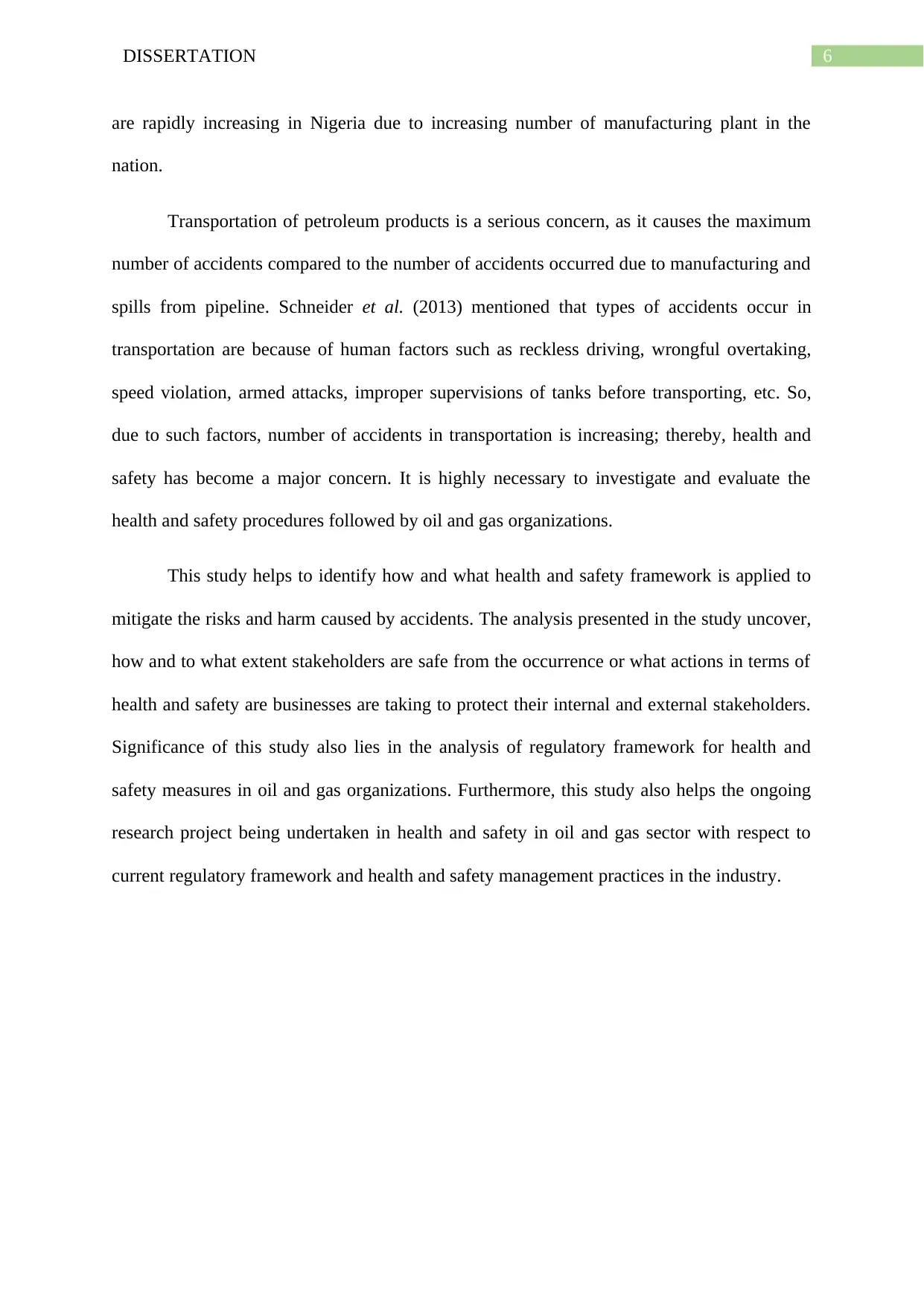
6DISSERTATION
are rapidly increasing in Nigeria due to increasing number of manufacturing plant in the
nation.
Transportation of petroleum products is a serious concern, as it causes the maximum
number of accidents compared to the number of accidents occurred due to manufacturing and
spills from pipeline. Schneider et al. (2013) mentioned that types of accidents occur in
transportation are because of human factors such as reckless driving, wrongful overtaking,
speed violation, armed attacks, improper supervisions of tanks before transporting, etc. So,
due to such factors, number of accidents in transportation is increasing; thereby, health and
safety has become a major concern. It is highly necessary to investigate and evaluate the
health and safety procedures followed by oil and gas organizations.
This study helps to identify how and what health and safety framework is applied to
mitigate the risks and harm caused by accidents. The analysis presented in the study uncover,
how and to what extent stakeholders are safe from the occurrence or what actions in terms of
health and safety are businesses are taking to protect their internal and external stakeholders.
Significance of this study also lies in the analysis of regulatory framework for health and
safety measures in oil and gas organizations. Furthermore, this study also helps the ongoing
research project being undertaken in health and safety in oil and gas sector with respect to
current regulatory framework and health and safety management practices in the industry.
are rapidly increasing in Nigeria due to increasing number of manufacturing plant in the
nation.
Transportation of petroleum products is a serious concern, as it causes the maximum
number of accidents compared to the number of accidents occurred due to manufacturing and
spills from pipeline. Schneider et al. (2013) mentioned that types of accidents occur in
transportation are because of human factors such as reckless driving, wrongful overtaking,
speed violation, armed attacks, improper supervisions of tanks before transporting, etc. So,
due to such factors, number of accidents in transportation is increasing; thereby, health and
safety has become a major concern. It is highly necessary to investigate and evaluate the
health and safety procedures followed by oil and gas organizations.
This study helps to identify how and what health and safety framework is applied to
mitigate the risks and harm caused by accidents. The analysis presented in the study uncover,
how and to what extent stakeholders are safe from the occurrence or what actions in terms of
health and safety are businesses are taking to protect their internal and external stakeholders.
Significance of this study also lies in the analysis of regulatory framework for health and
safety measures in oil and gas organizations. Furthermore, this study also helps the ongoing
research project being undertaken in health and safety in oil and gas sector with respect to
current regulatory framework and health and safety management practices in the industry.
Paraphrase This Document
Need a fresh take? Get an instant paraphrase of this document with our AI Paraphraser
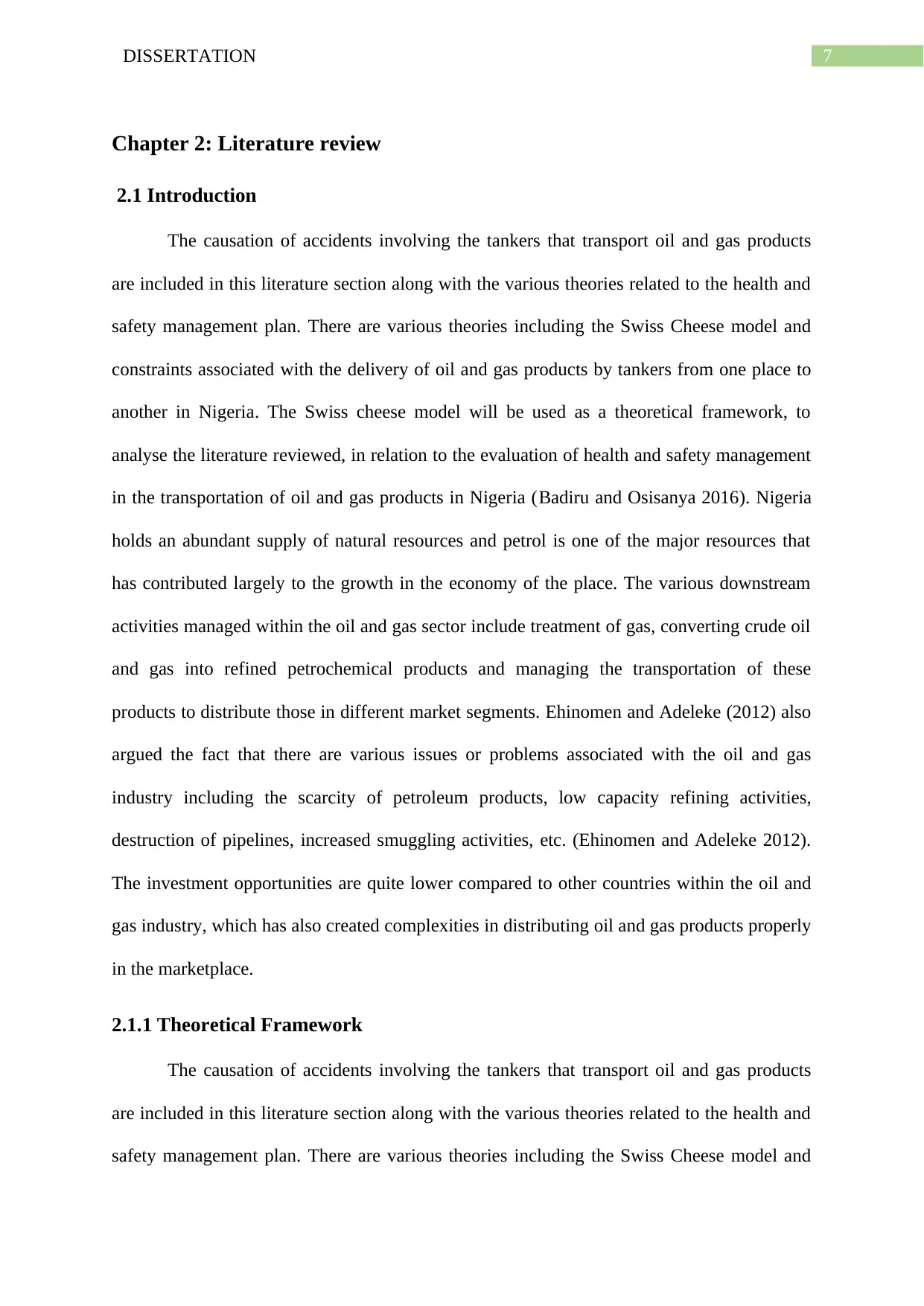
7DISSERTATION
Chapter 2: Literature review
2.1 Introduction
The causation of accidents involving the tankers that transport oil and gas products
are included in this literature section along with the various theories related to the health and
safety management plan. There are various theories including the Swiss Cheese model and
constraints associated with the delivery of oil and gas products by tankers from one place to
another in Nigeria. The Swiss cheese model will be used as a theoretical framework, to
analyse the literature reviewed, in relation to the evaluation of health and safety management
in the transportation of oil and gas products in Nigeria (Badiru and Osisanya 2016). Nigeria
holds an abundant supply of natural resources and petrol is one of the major resources that
has contributed largely to the growth in the economy of the place. The various downstream
activities managed within the oil and gas sector include treatment of gas, converting crude oil
and gas into refined petrochemical products and managing the transportation of these
products to distribute those in different market segments. Ehinomen and Adeleke (2012) also
argued the fact that there are various issues or problems associated with the oil and gas
industry including the scarcity of petroleum products, low capacity refining activities,
destruction of pipelines, increased smuggling activities, etc. (Ehinomen and Adeleke 2012).
The investment opportunities are quite lower compared to other countries within the oil and
gas industry, which has also created complexities in distributing oil and gas products properly
in the marketplace.
2.1.1 Theoretical Framework
The causation of accidents involving the tankers that transport oil and gas products
are included in this literature section along with the various theories related to the health and
safety management plan. There are various theories including the Swiss Cheese model and
Chapter 2: Literature review
2.1 Introduction
The causation of accidents involving the tankers that transport oil and gas products
are included in this literature section along with the various theories related to the health and
safety management plan. There are various theories including the Swiss Cheese model and
constraints associated with the delivery of oil and gas products by tankers from one place to
another in Nigeria. The Swiss cheese model will be used as a theoretical framework, to
analyse the literature reviewed, in relation to the evaluation of health and safety management
in the transportation of oil and gas products in Nigeria (Badiru and Osisanya 2016). Nigeria
holds an abundant supply of natural resources and petrol is one of the major resources that
has contributed largely to the growth in the economy of the place. The various downstream
activities managed within the oil and gas sector include treatment of gas, converting crude oil
and gas into refined petrochemical products and managing the transportation of these
products to distribute those in different market segments. Ehinomen and Adeleke (2012) also
argued the fact that there are various issues or problems associated with the oil and gas
industry including the scarcity of petroleum products, low capacity refining activities,
destruction of pipelines, increased smuggling activities, etc. (Ehinomen and Adeleke 2012).
The investment opportunities are quite lower compared to other countries within the oil and
gas industry, which has also created complexities in distributing oil and gas products properly
in the marketplace.
2.1.1 Theoretical Framework
The causation of accidents involving the tankers that transport oil and gas products
are included in this literature section along with the various theories related to the health and
safety management plan. There are various theories including the Swiss Cheese model and
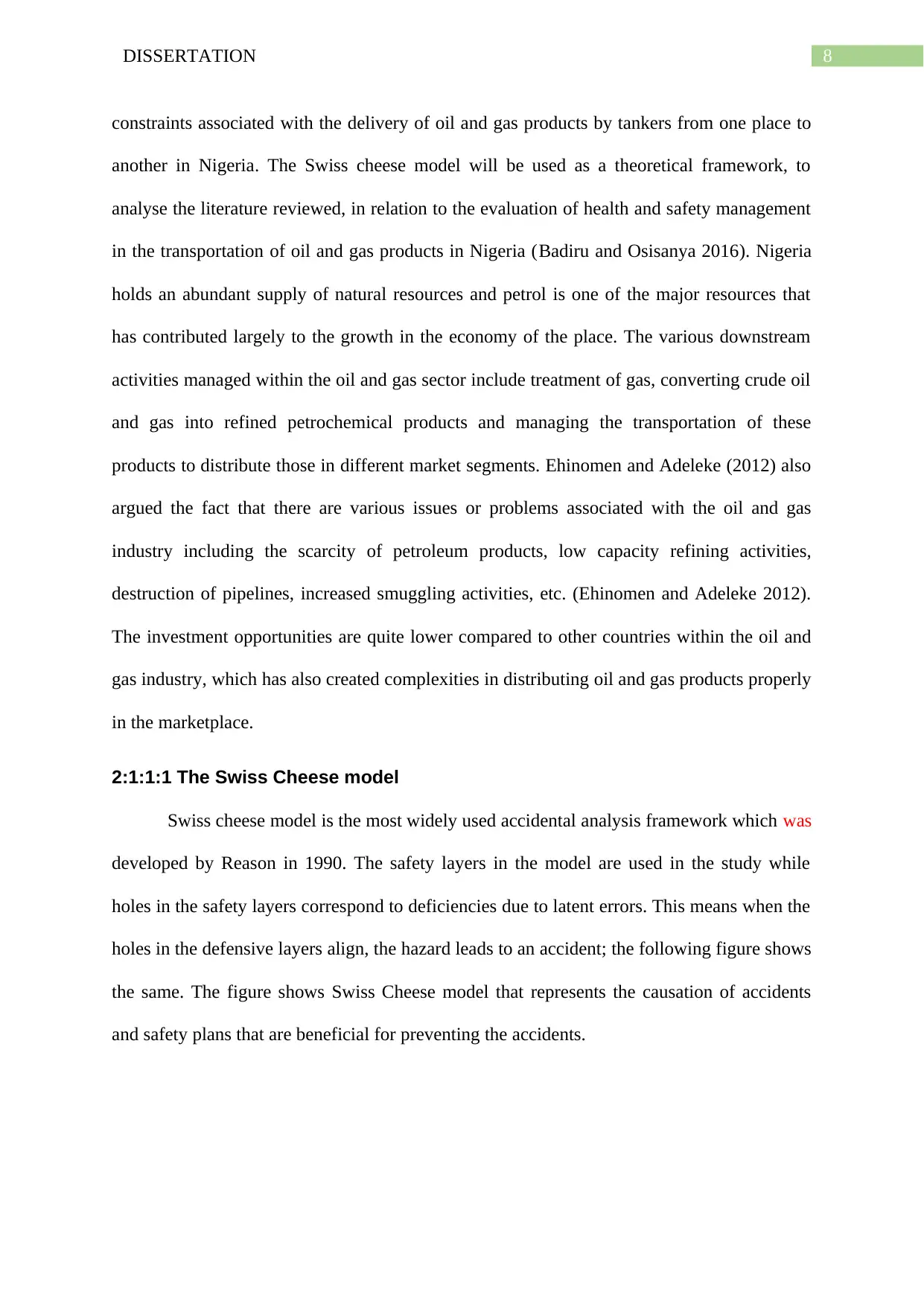
8DISSERTATION
constraints associated with the delivery of oil and gas products by tankers from one place to
another in Nigeria. The Swiss cheese model will be used as a theoretical framework, to
analyse the literature reviewed, in relation to the evaluation of health and safety management
in the transportation of oil and gas products in Nigeria (Badiru and Osisanya 2016). Nigeria
holds an abundant supply of natural resources and petrol is one of the major resources that
has contributed largely to the growth in the economy of the place. The various downstream
activities managed within the oil and gas sector include treatment of gas, converting crude oil
and gas into refined petrochemical products and managing the transportation of these
products to distribute those in different market segments. Ehinomen and Adeleke (2012) also
argued the fact that there are various issues or problems associated with the oil and gas
industry including the scarcity of petroleum products, low capacity refining activities,
destruction of pipelines, increased smuggling activities, etc. (Ehinomen and Adeleke 2012).
The investment opportunities are quite lower compared to other countries within the oil and
gas industry, which has also created complexities in distributing oil and gas products properly
in the marketplace.
2:1:1:1 The Swiss Cheese model
Swiss cheese model is the most widely used accidental analysis framework which was
developed by Reason in 1990. The safety layers in the model are used in the study while
holes in the safety layers correspond to deficiencies due to latent errors. This means when the
holes in the defensive layers align, the hazard leads to an accident; the following figure shows
the same. The figure shows Swiss Cheese model that represents the causation of accidents
and safety plans that are beneficial for preventing the accidents.
constraints associated with the delivery of oil and gas products by tankers from one place to
another in Nigeria. The Swiss cheese model will be used as a theoretical framework, to
analyse the literature reviewed, in relation to the evaluation of health and safety management
in the transportation of oil and gas products in Nigeria (Badiru and Osisanya 2016). Nigeria
holds an abundant supply of natural resources and petrol is one of the major resources that
has contributed largely to the growth in the economy of the place. The various downstream
activities managed within the oil and gas sector include treatment of gas, converting crude oil
and gas into refined petrochemical products and managing the transportation of these
products to distribute those in different market segments. Ehinomen and Adeleke (2012) also
argued the fact that there are various issues or problems associated with the oil and gas
industry including the scarcity of petroleum products, low capacity refining activities,
destruction of pipelines, increased smuggling activities, etc. (Ehinomen and Adeleke 2012).
The investment opportunities are quite lower compared to other countries within the oil and
gas industry, which has also created complexities in distributing oil and gas products properly
in the marketplace.
2:1:1:1 The Swiss Cheese model
Swiss cheese model is the most widely used accidental analysis framework which was
developed by Reason in 1990. The safety layers in the model are used in the study while
holes in the safety layers correspond to deficiencies due to latent errors. This means when the
holes in the defensive layers align, the hazard leads to an accident; the following figure shows
the same. The figure shows Swiss Cheese model that represents the causation of accidents
and safety plans that are beneficial for preventing the accidents.
⊘ This is a preview!⊘
Do you want full access?
Subscribe today to unlock all pages.

Trusted by 1+ million students worldwide
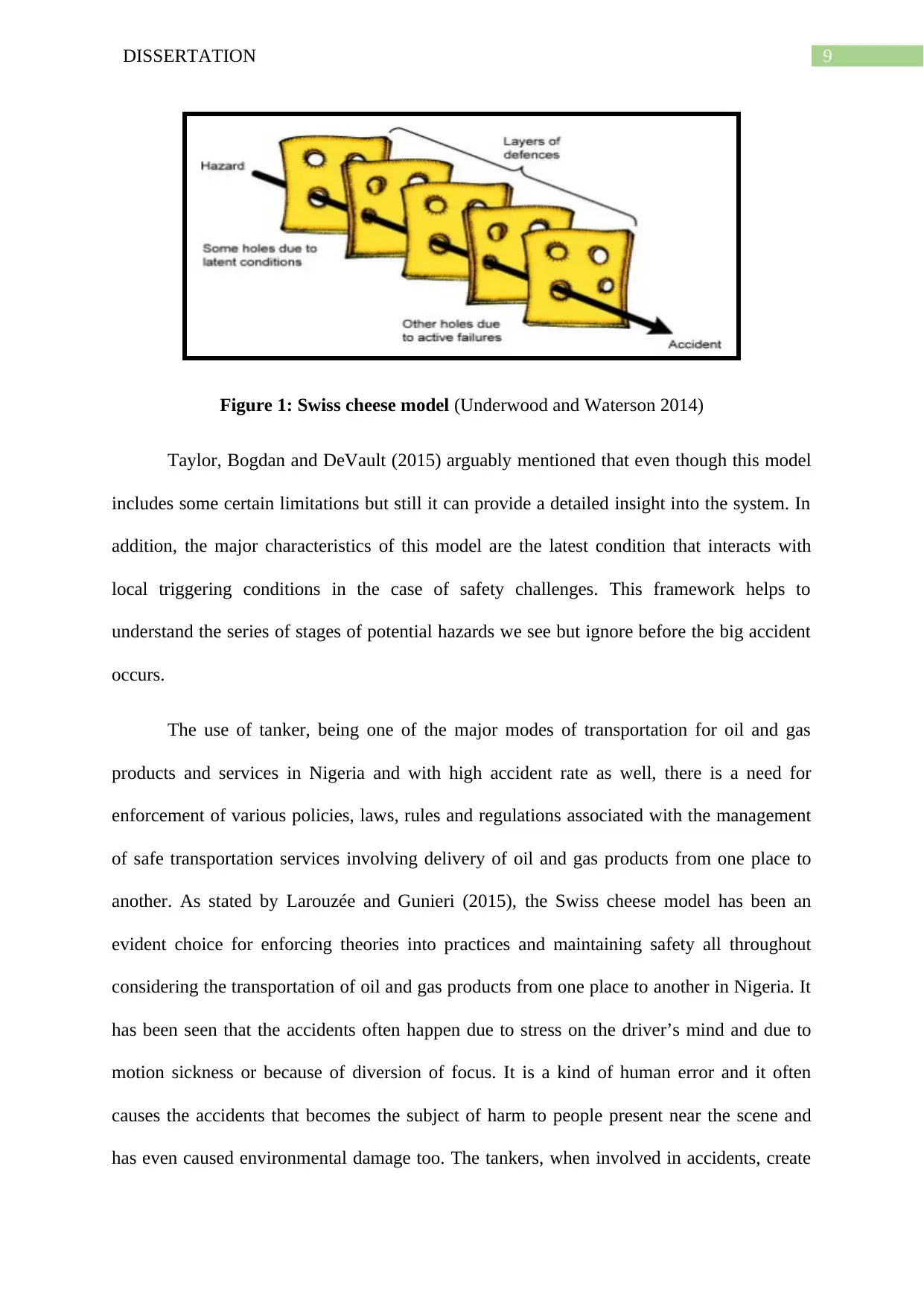
9DISSERTATION
Figure 1: Swiss cheese model (Underwood and Waterson 2014)
Taylor, Bogdan and DeVault (2015) arguably mentioned that even though this model
includes some certain limitations but still it can provide a detailed insight into the system. In
addition, the major characteristics of this model are the latest condition that interacts with
local triggering conditions in the case of safety challenges. This framework helps to
understand the series of stages of potential hazards we see but ignore before the big accident
occurs.
The use of tanker, being one of the major modes of transportation for oil and gas
products and services in Nigeria and with high accident rate as well, there is a need for
enforcement of various policies, laws, rules and regulations associated with the management
of safe transportation services involving delivery of oil and gas products from one place to
another. As stated by Larouzée and Gunieri (2015), the Swiss cheese model has been an
evident choice for enforcing theories into practices and maintaining safety all throughout
considering the transportation of oil and gas products from one place to another in Nigeria. It
has been seen that the accidents often happen due to stress on the driver’s mind and due to
motion sickness or because of diversion of focus. It is a kind of human error and it often
causes the accidents that becomes the subject of harm to people present near the scene and
has even caused environmental damage too. The tankers, when involved in accidents, create
Figure 1: Swiss cheese model (Underwood and Waterson 2014)
Taylor, Bogdan and DeVault (2015) arguably mentioned that even though this model
includes some certain limitations but still it can provide a detailed insight into the system. In
addition, the major characteristics of this model are the latest condition that interacts with
local triggering conditions in the case of safety challenges. This framework helps to
understand the series of stages of potential hazards we see but ignore before the big accident
occurs.
The use of tanker, being one of the major modes of transportation for oil and gas
products and services in Nigeria and with high accident rate as well, there is a need for
enforcement of various policies, laws, rules and regulations associated with the management
of safe transportation services involving delivery of oil and gas products from one place to
another. As stated by Larouzée and Gunieri (2015), the Swiss cheese model has been an
evident choice for enforcing theories into practices and maintaining safety all throughout
considering the transportation of oil and gas products from one place to another in Nigeria. It
has been seen that the accidents often happen due to stress on the driver’s mind and due to
motion sickness or because of diversion of focus. It is a kind of human error and it often
causes the accidents that becomes the subject of harm to people present near the scene and
has even caused environmental damage too. The tankers, when involved in accidents, create
Paraphrase This Document
Need a fresh take? Get an instant paraphrase of this document with our AI Paraphraser
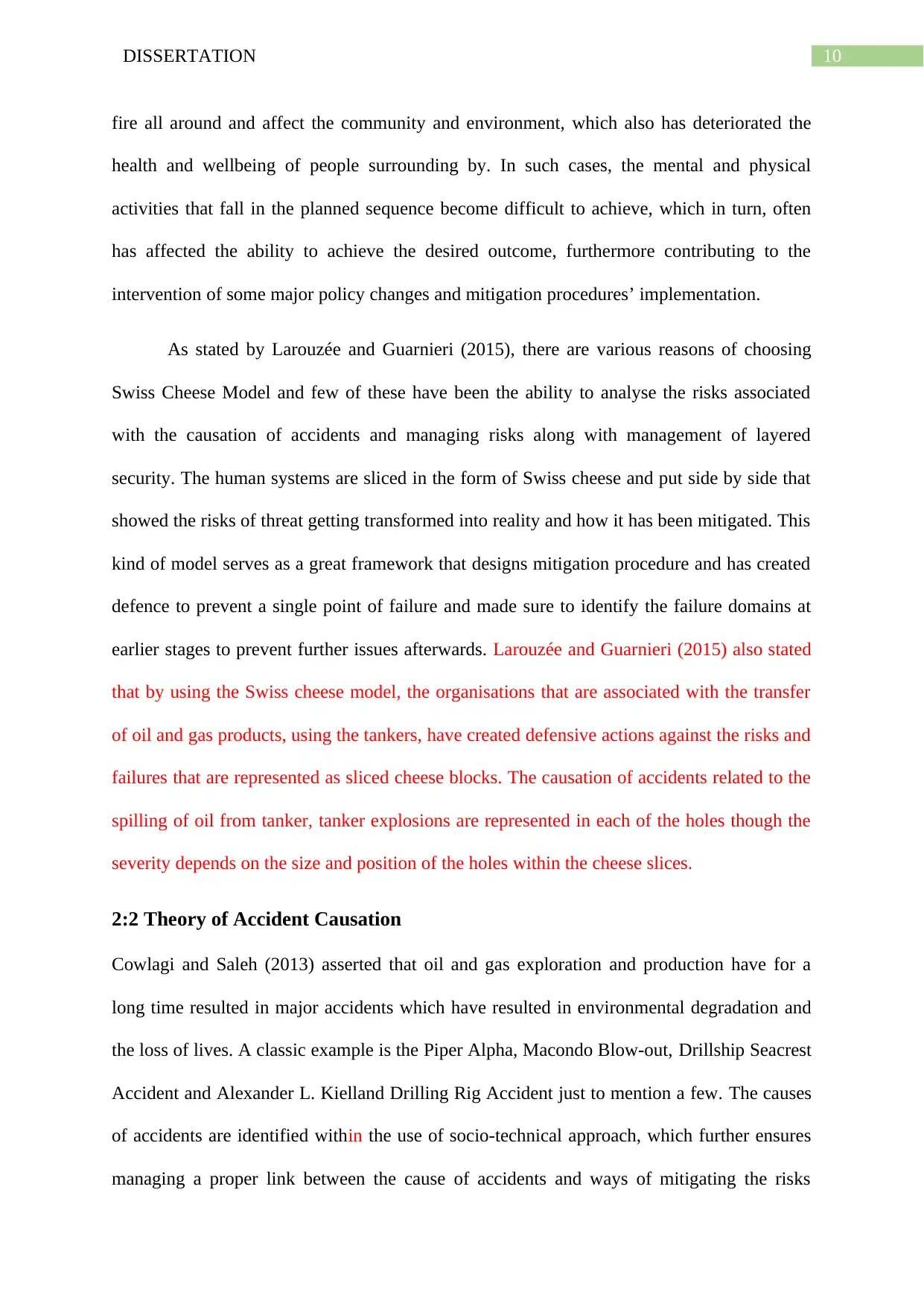
10DISSERTATION
fire all around and affect the community and environment, which also has deteriorated the
health and wellbeing of people surrounding by. In such cases, the mental and physical
activities that fall in the planned sequence become difficult to achieve, which in turn, often
has affected the ability to achieve the desired outcome, furthermore contributing to the
intervention of some major policy changes and mitigation procedures’ implementation.
As stated by Larouzée and Guarnieri (2015), there are various reasons of choosing
Swiss Cheese Model and few of these have been the ability to analyse the risks associated
with the causation of accidents and managing risks along with management of layered
security. The human systems are sliced in the form of Swiss cheese and put side by side that
showed the risks of threat getting transformed into reality and how it has been mitigated. This
kind of model serves as a great framework that designs mitigation procedure and has created
defence to prevent a single point of failure and made sure to identify the failure domains at
earlier stages to prevent further issues afterwards. Larouzée and Guarnieri (2015) also stated
that by using the Swiss cheese model, the organisations that are associated with the transfer
of oil and gas products, using the tankers, have created defensive actions against the risks and
failures that are represented as sliced cheese blocks. The causation of accidents related to the
spilling of oil from tanker, tanker explosions are represented in each of the holes though the
severity depends on the size and position of the holes within the cheese slices.
2:2 Theory of Accident Causation
Cowlagi and Saleh (2013) asserted that oil and gas exploration and production have for a
long time resulted in major accidents which have resulted in environmental degradation and
the loss of lives. A classic example is the Piper Alpha, Macondo Blow-out, Drillship Seacrest
Accident and Alexander L. Kielland Drilling Rig Accident just to mention a few. The causes
of accidents are identified within the use of socio-technical approach, which further ensures
managing a proper link between the cause of accidents and ways of mitigating the risks
fire all around and affect the community and environment, which also has deteriorated the
health and wellbeing of people surrounding by. In such cases, the mental and physical
activities that fall in the planned sequence become difficult to achieve, which in turn, often
has affected the ability to achieve the desired outcome, furthermore contributing to the
intervention of some major policy changes and mitigation procedures’ implementation.
As stated by Larouzée and Guarnieri (2015), there are various reasons of choosing
Swiss Cheese Model and few of these have been the ability to analyse the risks associated
with the causation of accidents and managing risks along with management of layered
security. The human systems are sliced in the form of Swiss cheese and put side by side that
showed the risks of threat getting transformed into reality and how it has been mitigated. This
kind of model serves as a great framework that designs mitigation procedure and has created
defence to prevent a single point of failure and made sure to identify the failure domains at
earlier stages to prevent further issues afterwards. Larouzée and Guarnieri (2015) also stated
that by using the Swiss cheese model, the organisations that are associated with the transfer
of oil and gas products, using the tankers, have created defensive actions against the risks and
failures that are represented as sliced cheese blocks. The causation of accidents related to the
spilling of oil from tanker, tanker explosions are represented in each of the holes though the
severity depends on the size and position of the holes within the cheese slices.
2:2 Theory of Accident Causation
Cowlagi and Saleh (2013) asserted that oil and gas exploration and production have for a
long time resulted in major accidents which have resulted in environmental degradation and
the loss of lives. A classic example is the Piper Alpha, Macondo Blow-out, Drillship Seacrest
Accident and Alexander L. Kielland Drilling Rig Accident just to mention a few. The causes
of accidents are identified within the use of socio-technical approach, which further ensures
managing a proper link between the cause of accidents and ways of mitigating the risks
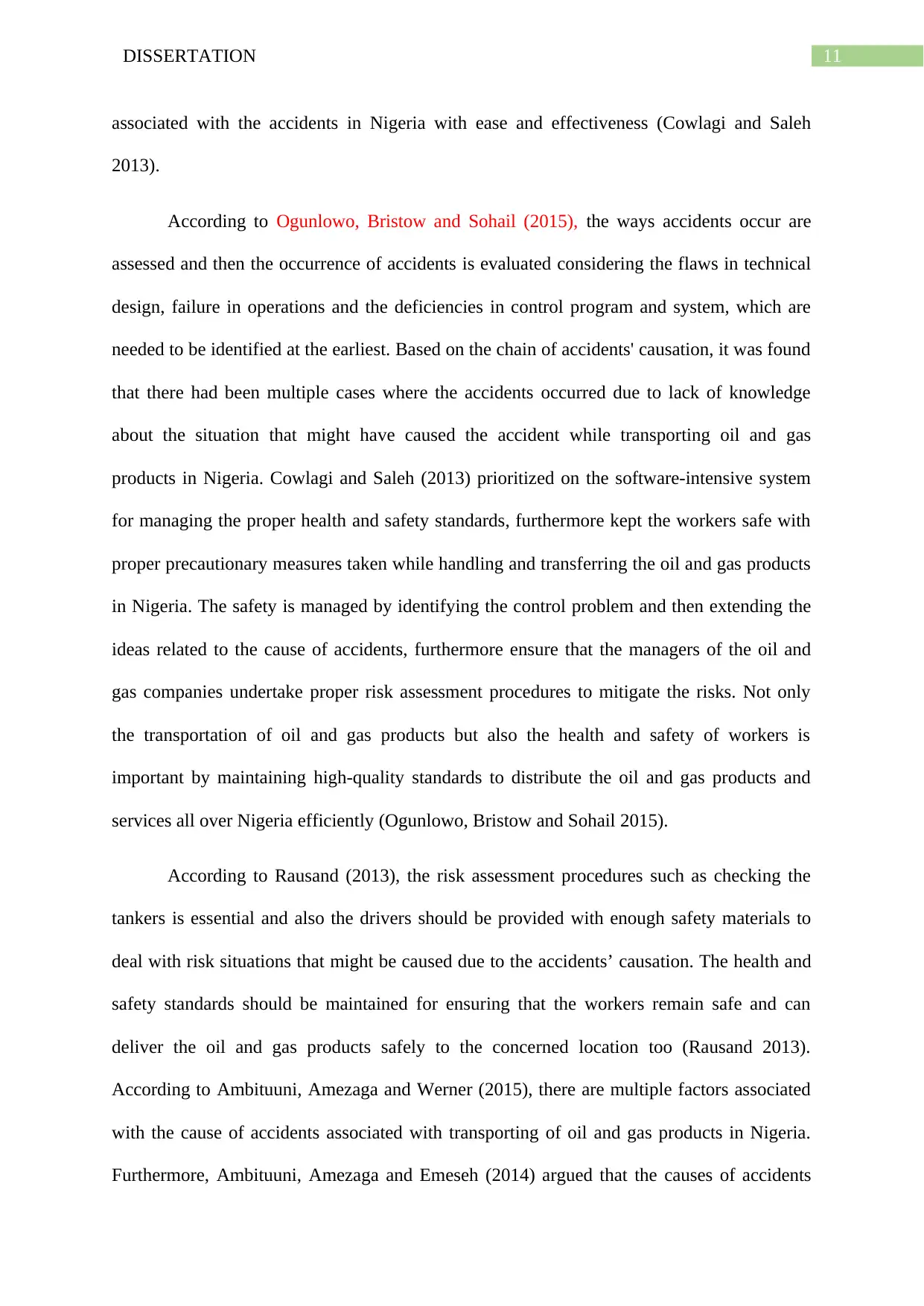
11DISSERTATION
associated with the accidents in Nigeria with ease and effectiveness (Cowlagi and Saleh
2013).
According to Ogunlowo, Bristow and Sohail (2015), the ways accidents occur are
assessed and then the occurrence of accidents is evaluated considering the flaws in technical
design, failure in operations and the deficiencies in control program and system, which are
needed to be identified at the earliest. Based on the chain of accidents' causation, it was found
that there had been multiple cases where the accidents occurred due to lack of knowledge
about the situation that might have caused the accident while transporting oil and gas
products in Nigeria. Cowlagi and Saleh (2013) prioritized on the software-intensive system
for managing the proper health and safety standards, furthermore kept the workers safe with
proper precautionary measures taken while handling and transferring the oil and gas products
in Nigeria. The safety is managed by identifying the control problem and then extending the
ideas related to the cause of accidents, furthermore ensure that the managers of the oil and
gas companies undertake proper risk assessment procedures to mitigate the risks. Not only
the transportation of oil and gas products but also the health and safety of workers is
important by maintaining high-quality standards to distribute the oil and gas products and
services all over Nigeria efficiently (Ogunlowo, Bristow and Sohail 2015).
According to Rausand (2013), the risk assessment procedures such as checking the
tankers is essential and also the drivers should be provided with enough safety materials to
deal with risk situations that might be caused due to the accidents’ causation. The health and
safety standards should be maintained for ensuring that the workers remain safe and can
deliver the oil and gas products safely to the concerned location too (Rausand 2013).
According to Ambituuni, Amezaga and Werner (2015), there are multiple factors associated
with the cause of accidents associated with transporting of oil and gas products in Nigeria.
Furthermore, Ambituuni, Amezaga and Emeseh (2014) argued that the causes of accidents
associated with the accidents in Nigeria with ease and effectiveness (Cowlagi and Saleh
2013).
According to Ogunlowo, Bristow and Sohail (2015), the ways accidents occur are
assessed and then the occurrence of accidents is evaluated considering the flaws in technical
design, failure in operations and the deficiencies in control program and system, which are
needed to be identified at the earliest. Based on the chain of accidents' causation, it was found
that there had been multiple cases where the accidents occurred due to lack of knowledge
about the situation that might have caused the accident while transporting oil and gas
products in Nigeria. Cowlagi and Saleh (2013) prioritized on the software-intensive system
for managing the proper health and safety standards, furthermore kept the workers safe with
proper precautionary measures taken while handling and transferring the oil and gas products
in Nigeria. The safety is managed by identifying the control problem and then extending the
ideas related to the cause of accidents, furthermore ensure that the managers of the oil and
gas companies undertake proper risk assessment procedures to mitigate the risks. Not only
the transportation of oil and gas products but also the health and safety of workers is
important by maintaining high-quality standards to distribute the oil and gas products and
services all over Nigeria efficiently (Ogunlowo, Bristow and Sohail 2015).
According to Rausand (2013), the risk assessment procedures such as checking the
tankers is essential and also the drivers should be provided with enough safety materials to
deal with risk situations that might be caused due to the accidents’ causation. The health and
safety standards should be maintained for ensuring that the workers remain safe and can
deliver the oil and gas products safely to the concerned location too (Rausand 2013).
According to Ambituuni, Amezaga and Werner (2015), there are multiple factors associated
with the cause of accidents associated with transporting of oil and gas products in Nigeria.
Furthermore, Ambituuni, Amezaga and Emeseh (2014) argued that the causes of accidents
⊘ This is a preview!⊘
Do you want full access?
Subscribe today to unlock all pages.

Trusted by 1+ million students worldwide
1 out of 44